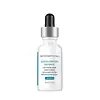What's inside
What's inside
 Key Ingredients
Key Ingredients

 Benefits
Benefits

 Concerns
Concerns

 Ingredients Side-by-side
Ingredients Side-by-side

Water
Skin ConditioningCaprylic/Capric Triglyceride
MaskingC13-15 Alkane
SolventTranexamic Acid
AstringentGlycerin
HumectantAlpha-Arbutin
AntioxidantPentylene Glycol
Skin ConditioningTocopheryl Acetate
AntioxidantPalmaria Palmata Extract
Skin ProtectingHydrolyzed Pea
Skin ConditioningAsparagopsis Armata Extract
Skin ProtectingAscophyllum Nodosum Extract
Skin ConditioningGlycyrrhiza Glabra Root Extract
BleachingPancratium Maritimum Extract
BleachingGanoderma Lucidum Extract
Skin ProtectingLentinus Edodes Extract
Skin ConditioningLactobacillus Ferment
Skin ConditioningHydrolyzed Pea Protein
EmollientDiacetyl Boldine
Skin ConditioningDipotassium Glycyrrhizate
HumectantLactobacillus
Skin ConditioningBisabolol
MaskingPanthenol
Skin ConditioningTocopherol
AntioxidantGlucose
HumectantArginine/Lysine Polypeptide
Skin ConditioningPentapeptide-34 Trifluoroacetate
EmollientC14-22 Alcohols
Emulsion StabilisingXanthan Gum
EmulsifyingHydrogenated Starch Hydrolysate
HumectantHydroxyacetophenone
AntioxidantSorbitan Caprylate
Emulsifying1,2-Hexanediol
Skin ConditioningCaprylyl Glycol
EmollientC12-20 Alkyl Glucoside
EmulsifyingPropanediol
SolventCarbomer
Emulsion StabilisingSodium Phytate
Butylene Glycol
HumectantSodium Chloride
MaskingSodium Succinate
BufferingSorbic Acid
PreservativeSodium Benzoate
MaskingPotassium Sorbate
PreservativePhenoxyethanol
PreservativeWater, Caprylic/Capric Triglyceride, C13-15 Alkane, Tranexamic Acid, Glycerin, Alpha-Arbutin, Pentylene Glycol, Tocopheryl Acetate, Palmaria Palmata Extract, Hydrolyzed Pea, Asparagopsis Armata Extract, Ascophyllum Nodosum Extract, Glycyrrhiza Glabra Root Extract, Pancratium Maritimum Extract, Ganoderma Lucidum Extract, Lentinus Edodes Extract, Lactobacillus Ferment, Hydrolyzed Pea Protein, Diacetyl Boldine, Dipotassium Glycyrrhizate, Lactobacillus, Bisabolol, Panthenol, Tocopherol, Glucose, Arginine/Lysine Polypeptide, Pentapeptide-34 Trifluoroacetate, C14-22 Alcohols, Xanthan Gum, Hydrogenated Starch Hydrolysate, Hydroxyacetophenone, Sorbitan Caprylate, 1,2-Hexanediol, Caprylyl Glycol, C12-20 Alkyl Glucoside, Propanediol, Carbomer, Sodium Phytate, Butylene Glycol, Sodium Chloride, Sodium Succinate, Sorbic Acid, Sodium Benzoate, Potassium Sorbate, Phenoxyethanol
Ingredients Explained
These ingredients are found in both products.
Ingredients higher up in an ingredient list are typically present in a larger amount.
Butylene Glycol (or BG) is used within cosmetic products for a few different reasons:
Overall, Butylene Glycol is a safe and well-rounded ingredient that works well with other ingredients.
Though this ingredient works well with most skin types, some people with sensitive skin may experience a reaction such as allergic rashes, closed comedones, or itchiness.
Learn more about Butylene GlycolCaprylyl Glycol is a humectant and emollient, meaning it attracts and preserves moisture.
It is a common ingredient in many products, especially those designed to hydrate skin. The primary benefits are retaining moisture, skin softening, and promoting a healthy skin barrier.
Though Caprylyl Glycol is an alcohol derived from fatty acids, it is not the kind that can dry out skin.
This ingredient is also used as a preservative to extend the life of products. It has slight antimicrobial properties.
Learn more about Caprylyl GlycolGlycerin is already naturally found in your skin. It helps moisturize and protect your skin.
A study from 2016 found glycerin to be more effective as a humectant than AHAs and hyaluronic acid.
As a humectant, it helps the skin stay hydrated by pulling moisture to your skin. The low molecular weight of glycerin allows it to pull moisture into the deeper layers of your skin.
Hydrated skin improves your skin barrier; Your skin barrier helps protect against irritants and bacteria.
Glycerin has also been found to have antimicrobial and antiviral properties. Due to these properties, glycerin is often used in wound and burn treatments.
In cosmetics, glycerin is usually derived from plants such as soybean or palm. However, it can also be sourced from animals, such as tallow or animal fat.
This ingredient is organic, colorless, odorless, and non-toxic.
Glycerin is the name for this ingredient in American English. British English uses Glycerol/Glycerine.
Learn more about GlycerinTranexamic Acid is best used for treating hyperpigmentation, discoloration, and melasma. It can also help build a stronger skin barrier.
Once applied, Tranexamic Acid starts decreasing inflammation from UV exposure. Tranexamic Acid also prevents our skin cells from meeting the pigment production cells.
Its brightening property makes it great at reducing the appearance of acne scars and marks.
Fun fact: Tranexamic Acid is also a medication used to reduce heavy bleeding.
This acid is derived from lysine, an amino acid.
Learn more about Tranexamic AcidWater. It's the most common cosmetic ingredient of all. You'll usually see it at the top of ingredient lists, meaning that it makes up the largest part of the product.
So why is it so popular? Water most often acts as a solvent - this means that it helps dissolve other ingredients into the formulation.
You'll also recognize water as that liquid we all need to stay alive. If you see this, drink a glass of water. Stay hydrated!
Learn more about WaterXanthan gum is used as a stabilizer and thickener within cosmetic products. It helps give products a sticky, thick feeling - preventing them from being too runny.
On the technical side of things, xanthan gum is a polysaccharide - a combination consisting of multiple sugar molecules bonded together.
Xanthan gum is a pretty common and great ingredient. It is a natural, non-toxic, non-irritating ingredient that is also commonly used in food products.
Learn more about Xanthan Gum